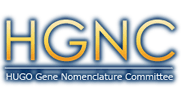HUGO Gene Nomenclature Committee
 | |
|---|---|
| Content | |
| Description | HGNC is responsible for approving unique symbols and names for human loci, including protein coding genes, RNA genes and pseudogenes, to allow unambiguous scientific communication. |
| Data types captured | Gene nomenclature |
| Organisms | Human |
| Contact | |
| Research center | EMBL-EBI, UK; |
| Primary citation | Gray & al. (2015)[1] |
| Access | |
| Website |
www www |
| Download URL |
Statistics & Downloads Custom Downloads HGNC Biomart |
| Web service URL |
rest |
| Tools | |
| Web | HGNC Comparison of Orthology Predictions,[2][3] Symbol report search |
| Miscellaneous | |
| Curation policy | Yes |
The HUGO Gene Nomenclature Committee (HGNC) is a committee of the Human Genome Organisation (HUGO) that sets the standards for human gene nomenclature. The HGNC approves a unique and meaningful name for every known human gene,[4] based on a query of experts. In addition to the name, which is usually 1 to 10 words long, the HGNC also assigns a symbol (a short group of characters) to every gene. As with an SI symbol, a gene symbol is like an abbreviation but is more than that, being a second unique name that can stand on its own just as much as substitute for the longer name. It may not necessarily "stand for" the initials of the name, although many gene symbols do reflect that origin.
Purpose
Especially gene abbreviations/symbols but also full gene names are often not specific for a single gene. A marked example is CAP which can refer to any of 6 different genes (BRD4, CAP1, LNPEP, PTPLA, SERPINB6, and SORBS1).
The HGNC short gene names, or gene symbols, unlike previously used or published symbols, are specifically assigned to one gene only. This can result in less common abbreviations being selected but reduces confusion as to which gene is referred to.
Naming guidelines
The HGNC summarises its approach to naming genes and assigning symbols (gene name abbreviations) as follows:
- gene symbols must be unique
- symbols should only contain Latin letters and Arabic numerals
- symbols should not contain punctuation or "G" for gene
- symbols do not contain any reference to the species they are encoded in, i.e. "H/h" for human
The full description of HGNC's nomenclature guidelines can be found on their web site . HGNC advocates the appendices _v1, _v2,.. to distinguish between different splice variants and _pr1, _pr2,.. for promoter variants of a single gene.
HGNC also states that "gene nomenclature should evolve with new technology rather than be restrictive as sometimes occurs when historical and single gene nomenclature systems are applied."[5]
Comprehensive human gene naming guidelines were last published in 2002,[6] but the HGNC has subsequently issued guides to specific locus types such as endogenous retroviral loci,[7] structural variants [8] and non-coding RNAs.[9][10]
Naming procedure
When assigning new gene nomenclature the HGNC make efforts to contact authors who have published on the human gene in question by email, and their responses to the proposed nomenclature are requested. HGNC also coordinates with the related Mouse and Rat Genomic Nomenclature Committees, other database curators, and experts for given specific gene families or sets of genes.
Revision
The gene name revision procedure is similar to the naming procedure, but changing a standardised gene name after establishment of a consensus can create confusion and the merit of this is therefore controversial. For this reason the HGNC aims to change a gene name only if agreement for that change can be reached among a majority of researchers working on that gene.
See also
References
- ↑ Gray, KA; Yates, B; Seal, RL; Wright, MW; Bruford, EA (Jan 2015). "Genenames.org: the HGNC resources in 2015.". Nucleic Acids Research. 43 (Database issue): D1079–82. doi:10.1093/nar/gku1071. PMC 4383909
 . PMID 25361968.
. PMID 25361968. - ↑ Wright, MW; Eyre, TA; Lush, MJ; Povey, S; Bruford, EA (Nov 2005). "HCOP: the HGNC comparison of orthology predictions search tool.". Mammalian genome : official journal of the International Mammalian Genome Society. 16 (11): 827–8. doi:10.1007/s00335-005-0103-2. PMID 16284797.
- ↑ Eyre, TA; Wright, MW; Lush, MJ; Bruford, EA (Jan 2007). "HCOP: a searchable database of human orthology predictions.". Briefings in bioinformatics. 8 (1): 2–5. doi:10.1093/bib/bbl030. PMID 16951416.
- ↑ http://www.genenames.org/about/overview
- ↑ Shows, TB; McAlpine, PJ; Boucheix, C; Collins, FS; Conneally, PM; Frézal, J; Gershowitz, H; Goodfellow, PN; et al. (1987). "Guidelines for human gene nomenclature. An international system for human gene nomenclature (ISGN, 1987)" (PDF). Cytogenetics and cell genetics. 46 (1–4): 11–28. PMID 3507270.
- ↑ Wain, HM; Bruford, EA; Lovering, RC; Lush, MJ; Wright, MW; Povey, S (Apr 2002). "Guidelines for human gene nomenclature.". Genomics. 79 (4): 464–70. doi:10.1006/geno.2002.6748. PMID 11944974.
- ↑ Mayer, J; Blomberg, J; Seal, RL (May 4, 2011). "A revised nomenclature for transcribed human endogenous retroviral loci.". Mobile DNA. 2 (1): 7. doi:10.1186/1759-8753-2-7. PMC 3113919
 . PMID 21542922.
. PMID 21542922. - ↑ Seal, RL; Wright, MW; Gray, KA; Bruford, EA (May 1, 2013). "Vive la différence: naming structural variants in the human reference genome.". Human genomics. 7: 12. doi:10.1186/1479-7364-7-12. PMC 3648363
 . PMID 23634723.
. PMID 23634723. - ↑ Wright, MW; Bruford, EA (Jan 2011). "Naming 'junk': human non-protein coding RNA (ncRNA) gene nomenclature.". Human genomics. 5 (2): 90–8. doi:10.1186/1479-7364-5-2-90. PMC 3051107
 . PMID 21296742.
. PMID 21296742. - ↑ Wright, MW (Apr 9, 2014). "A short guide to long non-coding RNA gene nomenclature.". Human genomics. 8 (1): 7. doi:10.1186/1479-7364-8-7. PMC 4021045
 . PMID 24716852.
. PMID 24716852.